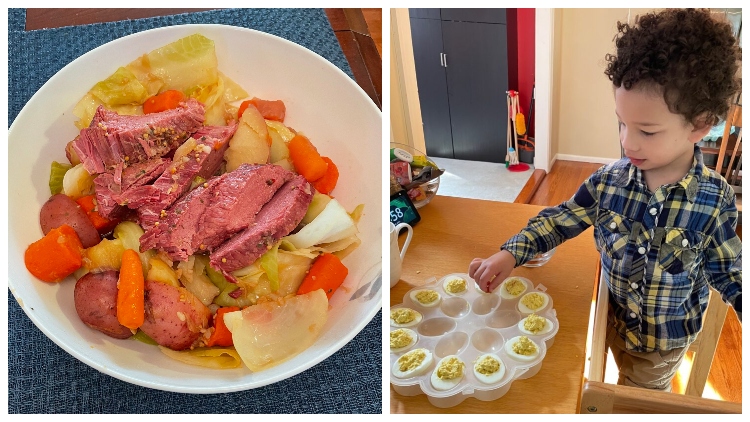Food Helped Me Feel More Connected To My Roots
Recently, I’ve been on a journey to discover more about myself. And the first step on the road toward self discovery was to dig into my roots.
I dove headfirst into an Ancestry search, filling out my family tree and sending in my DNA for analysis. Before the results came in, I had never known where my ancestors came from. I always assumed that we couldn’t trace my Black dad’s side past slavery. And because my (white) mother died before I knew what questions to ask (when I was just 6 years old), I just never knew much about where she came from. Because of the many redheads on that side of the family (my mother included), I just assumed Ireland was part of the equation.
I wasn’t wrong about Ireland. But it would turn out that I was a higher percentage of several other ethnicities. It took until I was 34 years old, but I finally found more definitive and concrete answers. It turned out that most of my roots stem from Nigeria and Scotland. My feelings on how my African and European roots fit together is a post for another day, but it was *a lot* to go from not knowing where I came from at all to seeing my distinctive roots color-coded on a map.

There’s a feeling of peace that comes with knowing more about yourself. But there’s also pain that comes with the learning. My roots on my father’s side lead straight through slavery to a continent and a country that seems so far away from my life, so beautifully different, that I feel like I have no real connection to it. And I’m still so in the dark about my mother’s family’s side of the story. Ancestry DNA helped paint a broad picture, but the history on the map is hard to connect to on an emotional level.
I’ve been thinking a whole lot about identity lately, and how, as a biracial person, I can connect to all parts of myself (when claiming any part of myself has always been difficult). But while preparing food for Thanksgiving last year, it hit me. There were certain foods I was making simply because our family just makes them. I didn’t think much about why. In other words, these food staples, for my family, were like roots.
The Familiar Roots of Soul Food
When I think of roots that I can connect to, food immediately comes to mind. I think of Thanksgiving in the kitchen with my dad, whipping up banana pudding from a recipe that only exists in our memories (how much sugar am I supposed to put in again?) My grandmother taught my dad how to make banana pudding, and now I make this special dessert for most holidays. On Easter, my very picky 3-year-old son gobbled it right up and asked for more.
I think of Mom (my stepmom) who doesn’t show up on that map but is a big part of my story, and whose roots are also my roots. I think of her mixing up a Southern-style potato salad that she doesn’t even like. But it was a staple for her growing up in Mississippi, and now, it’s our tradition too. We love it, and it reminds her of home, so she makes it. Sometimes, she’ll prepare the potato salad but leave all of the ingredients out on the counter. Then she’ll rely on me, as someone who loves the taste of our special dinner staple, to test it and tweak it until it’s just right. A little more mustard, a little more mayo. Maybe a tad more relish.
I think of deviled eggs, which I make any time appetizers are called for, because we always had deviled eggs for Thanksgiving, Christmas and Easter. Mom made them (another staple of the South), so I make them without really thinking about it. It’s like being a musician and having certain go-to songs — certain foods just become part of your repertoire. And this Easter, my son even helped prepare them, stirring the yolk mixture in a big bowl and sprinkling paprika on the top with his tiny hands.


There’s something immensely comforting about planning for a holiday and knowing that some of the dishes are already spoken for because they are dictated by tradition. These food traditions connect us to family members we may have known and lost, and family members who are just learning the ropes. On Easter, we will have deviled eggs, potato salad and banana pudding. No discussion needed. These roots are just as important as the roots I found on my Ancestry map. And they’re much more tangible (and easier to digest).
The Roots We Can’t See
The roots that we grow up with can be comfortingly familiar, but there’s something entirely different about roots that you don’t learn about until you’re older. Like a tree’s roots — planted so far under the surface that can’t be remembered because they are so deep down. But regardless of their visibility, they are part of what holds the tree up.
After I became a mom, my siblings (from my mother’s side) made me aware of a tradition they had enjoyed with our mother. Boiled Dinner (or Corned Beef and Cabbage) was just one of those dishes that was a staple, especially for St. Patrick’s Day. My sister taught me how to make it several years ago (do you really just pour a whole can of beer in there?) and now that I know it was a family tradition, I’ve incorporated it into my traditions. And any time I make it, it helps me feel more connected to those roots that I couldn’t see before.

My sister also recently gifted me a most prized possession; a box of handwritten recipes from my mother. I had never tried one of her recipes before (at least consciously). I had never even seen her handwriting.
I had originally thought that my mother had left nothing personal for me when she died. No video message, no heartfelt letter. Nothing in her own words. When I first saw the collection of handwritten recipes (a picture in a text message), the tears came immediately. I wasn’t sure why at first. It was just food, right? But of course it was much more than food. My mother had stood over these recipe cards. Her hands had carefully written ingredients and instructions down. She had followed each step of her own recipes and created deliciously comforting food that I might have even tried when I was a child. These recipes contained some of the roots I was missing.
My first stab at making one of her recipes was equal parts fun and emotional. I imagined us together in the kitchen — she, giving me instructions, but sitting back and sipping a cup of milky, sugary tea while letting me learn for myself, like a mother does. The Love Feast Buns didn’t come out perfectly, but the connection to my mother wasn’t just in the final product.

As my fingers traced the words on her recipe card, I was aware that my mother’s pen moved across that page. I knew that she followed the same directions that I was now following, in the exact same sequence. And as I kneaded the dough with my hands, I imagined us kneading together — though at different moments in history. But the act pulled me closer to her — to a part of her life that felt tangible. Though I have few memories, I can close my eyes and connect with my mother through the smell, the feel, the taste of our food roots. And now I have a whole box of recipes to work my way through.
The Food That Helps Us Tells Our Stories
Food tells a story about us. Food is something we pass down to our children as a story about where we came from. And food has the power (I now know from experience) to connect us to a past we couldn’t see with our eyes. When we taste it, we feel it in our soul.
In this current era of social justice and shining light on problematic “traditions” in our society, there’s a lot of customs that need reviewing. It’s important work that we need to be doing. But it’s also heavy work. So it’s nice to have food — yes, to devour when we need comfort, but also as a solid staple of identity. We can always come back to our food roots when we feel like we need a taste. Though a recipe may be complicated, the food and the act of making it is not mentally complicated. It doesn’t make us grapple with our identities (like an Ancestry DNA map). With recipes, we can just create and connect.
Through food, I can connect to my son, my dad, and my stepmom. I can connect with my husband and his family through their special food traditions. And I can connect to the people who aren’t here anymore but are undoubtedly a part of me; whether it be my great grandmother who lived in the Jim Crow south, or my mother who didn’t have time to tell me her origin story.
We can’t recreate a history we’ve missed out on. But we can recreate recipes. And it turns out, in the journey of getting closer to the heart of where I come from, food is a key ingredient.

